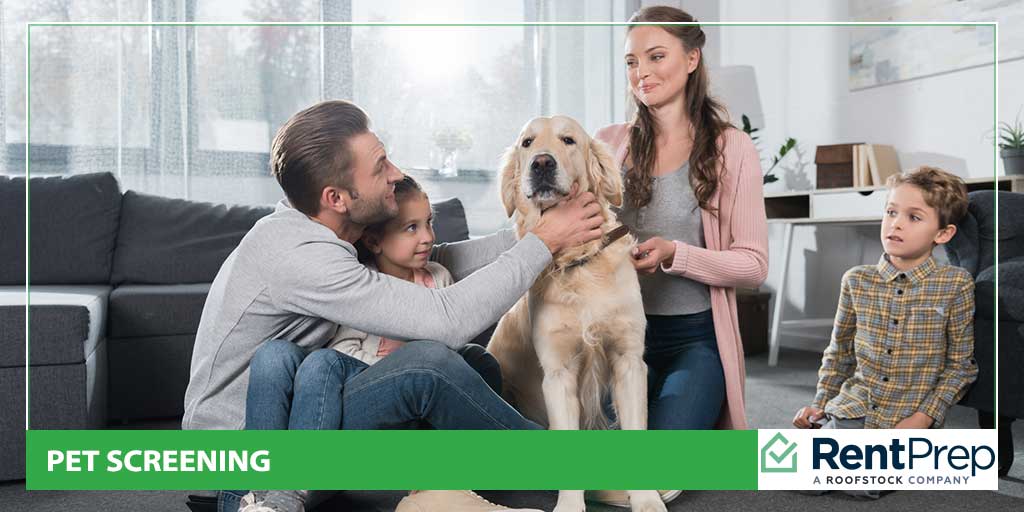
Landlords who allow pets do so under specific regulations that protect their properties, and pet screening is a big part of how these landlords succeed.
Without a pet interview or screening, landlords may accept tenants with pets that aren’t a good fit for the property. The relationship between landlord and tenant needs to include the tenant’s pets if they’ll be staying at the property, and this means you need to meet any prospective tenants’ pets before they move in.
What should you look for when doing a pet screening for apartments or properties in your portfolio? Today, learn all about these interviews, how pet screening works, and why doing screenings is vital for your long-term success.
A Table Of Contents On Pet Screening
Pet screening is a relatively simple concept, but it requires a good grasp of what information you’re looking for. Like tenant screening, you won’t be able to determine if the pet is appropriate for the property without asking the right questions. Follow along to learn more:
- What Is A Pet Screening?
- How Does Pet Screening Work?
- Pet Screening For Apartments: Step-By-Step Guide For Landlords
- FAQs: How Does Pet Screening Work?
- Establish Security When Allowing Pets
What Is A Pet Screening?

A pet screening, like a tenant screening, is a type of background check. This check looks into the pet’s size, behavior, health, and other important factors that could affect how well a pet will fit in with a specific property and local community.
Third-party vendors run some pet screening services, but most landlords complete the screening independently. This is typically done by collecting information through a pet application and meeting the animal at a pet interview. By completing these two steps, landlords can decide about allowing the pet to stay at the property.
Pet screening is important before allowing any animals at a rental property. All pets present some type of risk. Much of that risk is manageable, but you always want to be sure that you take the necessary precautions. That starts with proper pet screening.
The Key Points Of Pet Screening
Banning pets from your properties massively limits the pool of potential tenants. However, renting to tenants with pets can also be a liability. Utilize thorough pet screening to ensure you do not miss any significant red flags.
The main things you want to look for during a pet screening are whether or not the dog or other type of pet is likely to be aggressive or harmful to you or any others at the property. Damage caused to a property by a pet can be fixed with funds from the security deposit, but a dog attack could be a significant liability for everyone involved.
You also want to be sure the pet doesn’t make an excessive amount of noise. This could cause issues, such as noise complaints, between the tenants and their neighbors. Avoiding these situations altogether is best.
How Does Pet Screening Work?
Pet screenings are completed by either the landlord or a third-party service hired by the landlord.
In either case, the tenant must fill out a pet application for all pets that would be occupying the property. The application covers basic details as well as more specifics on behavior, personality, housetraining, and medical topics.
Next, a pet interview is scheduled. During this interview, the pet is assessed to ensure there are no major red flags, such as aggression, to be concerned about. Dogs are walked around the property to ensure they will be comfortable and non-aggressive in the neighborhood.
Pet Screening For Apartments: Step-By-Step Guide For Landlords
Ready to start accepting tenants with pets? Here’s what to do to ensure you are correctly screening the pets just as well as you screen your tenant applicants.
1. Outline All Pet Rules And Guidelines
Be sure that all prospective tenants are clear on your pet rules, restrictions, and fees. Pet deposit rules, for example, should be outlined to detail what will be taken out of the deposit before it is returned.
Keeping both parties on the same page is critical to successful communication. This allows tenants to ask pet-related questions before signing the lease, hopefully preventing miscommunication.
2. Give Tenant A Pet Screening Application
It’s essential to ensure that all pets match well with your rental property. For example, large dogs that are very loud will likely not be a good fit for a tiny studio in a multi-unit complex.
Gather the information you need about the pet by collecting a pet screening application. This application should ask for the following about the pet:
- Name
- Age
- Height and weight
- Breed
- Medical history
- Length of ownership
- Housetraining status
- Behavioral issues (if any)
- Proof of vaccinations
- Previous history of aggression (if any)
Once you have this information, keep it on file so it can be referenced at any time.
3. Conduct A Pet Interview

Generally, meeting the pet in person is also a good idea. This is especially true when you’re unsure about a pet’s behavior from the application or are concerned about its presence in a multi-family rental property.
During this interview, confirm that the pet from the application is the same as the pet you are meeting. Pay attention to how well it listens to its owner, whether it shows any signs of aggression, and what it does when it encounters other individuals.
Throughout this process, remember that new situations can make pets nervous. Understand that it can be stressful for the animal as they enter new surroundings, and pay attention to their general behavior instead.
4. Ensure Legal Complicity
Before you approve or deny a tenant’s pet, double-check all local, state, and federal pet laws. There may be laws in effect that override your decision.
For example, The Fair Housing Act includes rules about reasonable accommodations for service animals. This means you may not be able to deny a service animal even if you have a no-pets policy in place. Review the specifics to ensure you are following all necessary regulations.
5. Include Pet Rules In The Lease
Finally, make sure you add a pet addendum to the lease. This is key for keeping everyone accountable regarding the pet, the pet deposit, and what actions will be taken if the rules are not followed. Keep this on file once the lease has been signed for future reference.
Screening Pets, Screening People
While we’re on the topic of the importance of screening pets, don’t forget that it’s also essential to screen all prospective tenants thoroughly before accepting them as tenants.
Tenant screening can be an exhausting process. Many details need to be reviewed, and it’s often hard to know exactly what you’re looking for. As you refine your screening technique, hiring a third-party service to help may be beneficial.
That’s where we fit in.
At RentPrep, we have various tenant screening options, including tenant background checks, credit reports, and more. Give our services a try to simplify your tenant screening process, and spend more time on what matters most to you.
FAQs: How Does Pet Screening Work?
Pet screening and pet interviews aren’t conducted by all landlords. If you’re a new landlord, this may be the first time you’re heard about these activities. Keep reading for answers to the most frequently asked questions about pet screening:
What is a pet interview for an apartment?
Landlords often conduct pet interviews to determine if a pet is a good fit for the community and the property. The primary purpose of the interview is to ensure the pet is well-behaved, as described, and relatively friendly.
Pet interviews allow you to confirm any information a tenant told you about the pet for yourself. Additionally, you can check if the pet has blatant aggressions or excessive behaviors that may make it challenging to allow at the property. Once you confirm the pet is a good fit for the property, it’s much easier to move forward with the rental contract.
What does a pet screening consist of?
The exact procedure of a pet screening varies from landlord to landlord. You have a few options when deciding what will be included in your pet screenings.
First, you’ll want to decide what to include in your pet application. This document collects all the basic information you need about the tenant’s pet, such as their name, breed, size, personality, and medical issues. Gathering this data helps you get a better picture of what the animal is like.
Second, you’ll want to schedule a pet interview. During the interview, you will have the opportunity to meet the pet and see how they interact and behave. Pets that are well-behaved stand out as approval-ready, while others may cause you to hesitate about moving forward.
Some landlords choose to outsource the pet screening process to a third party. Vendors complete these reports by meeting the pet and talking to the tenant. This allows you to spend less time on the pet screening process while gathering data to make your decision.
What is a good reason for a landlord to say no to pets?
The biggest reason landlords choose not to allow pets is the damage that pets can cause. Replacing carpets, subfloors, and other items destroyed by pets is incredibly costly. Even if a pet deposit is collected, the repair investment is often taxing for landlords.
Also, some landlords don’t want to risk loud or unruly pets causing problems with other tenants. In multi-unit buildings, a dog that barks when home alone or gets aggressive around other animals is a considerable risk. To avoid potential liability issues, landlords often choose not to allow pets.
How do apartments check dog poop to find the owner?
In recent years, some multi-unit complexes started requiring dog owners to have their dog’s DNA added to a database when registering the pet. This is done by simply swabbing the dog’s cheek for a sample before sending it to a specialized laboratory.
When staff finds fecal matter on the property that hasn’t been adequately cleaned up, it can be collected and mailed out to determine who is responsible for the mess. This enables property owners to enforce rules about cleaning up after pets more strictly and encourages pet owners to take proper clean-up steps when walking their dogs.
How do apartments determine dog breed?
Landlords may be unsure about an animal’s breed, and it can be hard to know just by looking at the dog. The best way to verify the dog’s breed is to look at its medical records. Most veterinary records will include the dog’s species or assumed breed. Veteranians are much more experienced with dog breeds than ordinary people, so their word can be trusted.
Can landlords legally forbid pets or certain dog breeds?
In most states, landlords are legally allowed to forbid pets or certain breeds. This means that a landlord can allow cats only, dogs only, or only animals under a specific size. It is up to them to dictate these rules.
The only laws in place are about assistance animals. Tenants with service animals must be given reasonable accommodations. The Fair Housing Act requires that service animals be permitted unless they represent a threat to others occupying the property.
It’s important to check local and state laws to finalize what you do and do not allow on your property. Some locales may have different rules about specific pet breeds, for example, that you should be aware of. Be sure you search to ensure that you are not accidentally crossing any legal boundaries when determining what you do and do not allow.
Establish Security When Allowing Pets
The key takeaway when learning about pet screening is that enacting a pet screening requirement is a way to establish additional security for your properties.
Before you rent to any prospective tenants, you review their applications, run background checks, and ensure they are honest individuals who will become respectful tenants.
A similar process should be done with all pets. Like their human-tenant counterparts, pets can cause a lot of damage to property. Much of that damage will take far more than a security deposit to fix, and it can be hard to reclaim the full value lost. Ensuring that only appropriate pets are occupying your property is an excellent way to secure your property’s value.
Make sure you check the following when reviewing pet applications and conducting pet interviews:
- Does the pet have a history of aggression or important medical issues?
- Does the pet understand basic commands?
- Does the pet exhibit any problematic behavior? (i.e., excessive barking)
These three things provide a great baseline for conducting pet screening. Make sure you incorporate pet screening into your routine if you accept tenants with pets at your properties.

